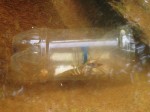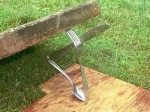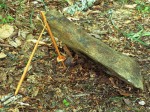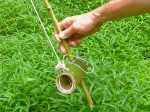| |

|
Soda Bottle Fish Trap
Did you know that you can modify an empty plastic soda bottle in order to make a fish trap?
The neck of the soda bottle makes a great funnel, and the body of the bottle makes a great cage. In essence, if you reverse the neck direction to face the body, what goes in the funnel lands in the cage. So, with a knife or scissors, pierce the side of the bottle at it’s widest point below the bottle neck and cut around the circumference of the bottle, then remove the neck, turn it around and insert it into the body, and viola!, you have a fish trap. You can either eat the critters that you catch, or, you can use them for bait to catch something bigger. For more details, see my blog “Soda Bottle Fish Trap“.
|

|
Silverware Figure-4 Deadfall
I came up with a workable configuration of a spoon, fork and knife as a trigger for a figure-4 deadfall. It begins with a spoon placed on the table face-up. When the weight of the deadfall is placed on the fork’s tip, the pressure will keep the assembly in balance. Because of the spoon’s slippery nature and the delicate counter weight of the knife, it’s quite easy to trigger. Of course, don’t forget to put bait on the handle of the spoon, which should be facing inside and under the leaning deadfall. The bait can be peanut butter, butter or grease… something that will stay adhered to the handle. Check out my blog for more details…
|

|
Bamboo Chopstick Deadfall
While I was doing some grocery shopping, I saw a package of bamboo chopsticks on display. My eyes glazed over as I envisioned a two-stick deadfall incorporating these timeless culinary tools. I began modifying the first stick by cutting the thin tip into a slightly flat chisel edge. The thick end, or handle, will be set on the ground and this piece becomes the upright support. The second stick we’ll call the “bait stick”. The handle (thick end) will have a top side and bottom side. On the top side I began to make a notch starting 1″ from the end, and cutting about 1/16″ into the stick and tapering out an inch toward the narrow end. Beneath this cut, on the bottom side, I cut a series of slight perpendicular grooves that when assembled will be placed over the chisel point of the support stick. You can cut grooves around the sharp end to better secure the bait.The size of the bamboo chopstick trigger will work for small animals but by applying the same construction to larger sticks, it can be scaled up for larger game. When trapping, it’s wise to set up multiple traps to increase you chances of success. Check out my blog for more details for set-up procedures…
|

|
Tilong Rodent Trap
This trap is traditionally made with bamboo but can easily be made out of alternate materials such as saplings and tin cans. The trap consists of a hollow bamboo tube, a springy branch with cord and toggle, a small cord anchor loop, a large cord snare loop, and a tethered trigger stick. When the toggle is threaded through the snare loop, and is held down by the anchor loop and trigger stick, the snare loop is positioned inside the bamboo tube by the opening. When the rodent sticks it’s head into the tube and sets off the trigger stick, the snare loop tightens around the neck of the rodent and pins it against the roof of the tube. The branch extends through the tube and is driven into the ground to keep it in place, thus preventing it from being dragged away from a struggling animal. As usual, several traps are set out to increase the chances of success. For more details on this method, see my blog Tilong Rodent Trap.
|









